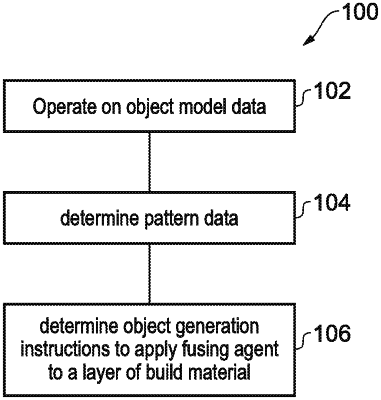| CPC B29C 64/386 (2017.08) [B22F 10/80 (2021.01); B33Y 50/00 (2014.12); G05B 19/4099 (2013.01); G05B 2219/35012 (2013.01); G05B 2219/45028 (2013.01); G06F 30/10 (2020.01); G06F 2113/10 (2020.01)] | 16 Claims |

|
1. A method of additive manufacturing comprising:
operating, by a processor, on an object model data describing a pattern area that is at least part of an object to be generated in additive manufacturing, and a non-pattern area that is the remainder of the object outside of the pattern area;
determining, by the processor, a unique identifier pattern data comprising areas of variable reflectance intended to be formed on the pattern area, wherein the unique identifier pattern data is added to the object model data to identify the object to be generated;
determining, by a processor, object generation instructions to apply a single color fusing agent to some portion of a layer of a build material for an entirety of the object including the pattern and the non-pattern area of the object to be generated by fusing the build material,
wherein the single color fusing agent is applied to the non-pattern area at a first or standard density and wherein the single color fusing agent is applied to the pattern area at a second density higher than the standard density of the non-pattern area and at a third density lower than the standard density of the non-pattern area to correspond to the areas of variable reflectance of the unique identifier data pattern to identify the object to be generated; and
controlling an additive manufacturing printing apparatus using control data generated based on the object generation instructions to generate the object in a plurality of layers.
|